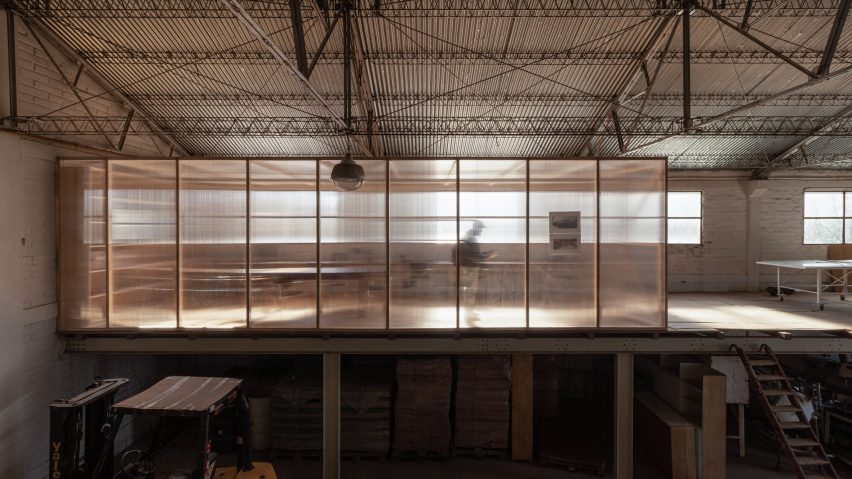Local studio Atelier Industrial has created a minimalist office with walls made from polycarbonate panels within an existing warehouse in San Rafael, Argentina.
The studio placed the small, 67-square-metre office space within an area of an industrial warehouse that is part of a winery in the city.
Called Atelier Cuadro Benegas, it sits on top of a platform in a double-height space with a vaulted metal ceiling and brick walls. Because of the small area on top of the built-in storage platform, the studio opted for an approach that centred on what it called an "aesthetic of the essential".
The walls of the office are made from polycarbonate that allows light to enter but is also opaque enough to blur the activity within the warehouse.
Its framing is relatively simple, with an array of laminated timber beams holding up a flat ceiling with exposed wooden rafters. A second floor made from plywood was installed on top of the platform.
The rafters of the office were meant to resemble formally the space of the warehouse itself, and the newbuild utilises two of the white-painted brick walls of the warehouse for its walls, which were left exposed for one side of the structure.
"Light and subtle, the industrial character of the surfaces is confused thanks to the diffuse conditions generated by the polycarbonate panels," said Atelier Industrial.
"Its architectural suitability [is] both discreet and basic."
"The monotonous system of thirteen columns and ten beams generates from this space a mirror of its own environment, making this pavilion transmit light, receive it, allowing itself to be penetrated by it, so as to become luminous itself."
A narrow step ladder leads up the the platform, and workers can enter the polycarbonate space through a door that has double hinges to allow for flexibility in the small space.
Inside, a row of desks lines the outside-facing brick wall and operable windows allow for light and ventilation.
At the centre of the space are tables for sharing tasks, while at the far end, a row of bookshelves has been placed against the brick wall, framing a window that faces another room in the warehouse.
The studio noted that the design was chosen because it can easily assembled and disassembled.
Overall, the design was established to allow for the space to function independently, while still being a part of the warehouse and the winery complex in general.
Other projects that implant smaller volumes within warehouse spaces include a flat in Melbourne within a former chocolate factory.
Recently, Tokyo studio Arii Irie Architects created a warehouse lined with polycarbonate panels that doubles as a residence.
The photography is by Luis Abba.

